This is a preprint.
Proximal immune-epithelial progenitor interactions drive chronic tissue sequelae post COVID-19
- PMID: 37745354
- PMCID: PMC10515929
- DOI: 10.1101/2023.09.13.557622
Proximal immune-epithelial progenitor interactions drive chronic tissue sequelae post COVID-19
Abstract
The long-term physiological consequences of SARS-CoV-2, termed Post-Acute Sequelae of COVID-19 (PASC), are rapidly evolving into a major public health concern. The underlying cellular and molecular etiology remain poorly defined but growing evidence links PASC to abnormal immune responses and/or poor organ recovery post-infection. Yet, the precise mechanisms driving non-resolving inflammation and impaired tissue repair in the context of PASC remain unclear. With insights from three independent clinical cohorts of PASC patients with abnormal lung function and/or viral infection-mediated pulmonary fibrosis, we established a clinically relevant mouse model of post-viral lung sequelae to investigate the pathophysiology of respiratory PASC. By employing a combination of spatial transcriptomics and imaging, we identified dysregulated proximal interactions between immune cells and epithelial progenitors unique to the fibroproliferation in respiratory PASC but not acute COVID-19 or idiopathic pulmonary fibrosis (IPF). Specifically, we found a central role for lung-resident CD8+ T cell-macrophage interactions in maintaining Krt8hi transitional and ectopic Krt5+ basal cell progenitors, thus impairing alveolar regeneration and driving fibrotic sequelae after acute viral pneumonia. Mechanistically, CD8+ T cell derived IFN-γ and TNF stimulated lung macrophages to chronically release IL-1β, resulting in the abnormal accumulation of dysplastic epithelial progenitors and fibrosis. Notably, therapeutic neutralization of IFN-γ and TNF, or IL-1β after the resolution of acute infection resulted in markedly improved alveolar regeneration and restoration of pulmonary function. Together, our findings implicate a dysregulated immune-epithelial progenitor niche in driving respiratory PASC. Moreover, in contrast to other approaches requiring early intervention, we highlight therapeutic strategies to rescue fibrotic disease in the aftermath of respiratory viral infections, addressing the current unmet need in the clinical management of PASC and post-viral disease.
Figures

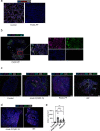
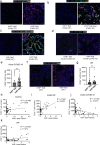
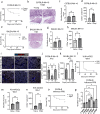

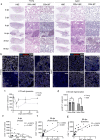

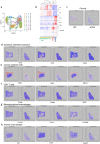
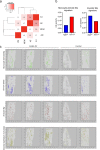
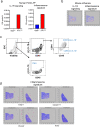
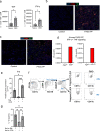

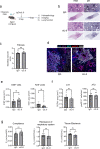


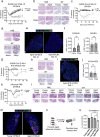
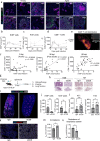
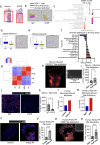
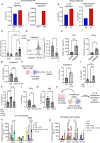
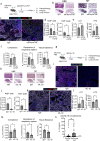
Similar articles
-
Proximal immune-epithelial progenitor interactions drive chronic tissue sequelae post COVID-19.Res Sq [Preprint]. 2023 Nov 28:rs.3.rs-3587418. doi: 10.21203/rs.3.rs-3587418/v1. Res Sq. 2023. Update in: Nature. 2024 Oct;634(8035):961-969. doi: 10.1038/s41586-024-07926-8. PMID: 38077031 Free PMC article. Updated. Preprint.
-
An aberrant immune-epithelial progenitor niche drives viral lung sequelae.Nature. 2024 Oct;634(8035):961-969. doi: 10.1038/s41586-024-07926-8. Epub 2024 Sep 4. Nature. 2024. PMID: 39232171
-
Caveolin Scaffolding Domain (CSD) Peptide LTI-2355 Modulates the Phagocytic and Synthetic Activity of Lung-Derived Myeloid Cells in Idiopathic Pulmonary Fibrosis (IPF) and Post-Acute Sequelae of COVID Fibrosis (PASC-F).Biomedicines. 2025 Mar 26;13(4):796. doi: 10.3390/biomedicines13040796. Biomedicines. 2025. PMID: 40299362 Free PMC article.
-
Post-COVID pulmonary sequelae: Mechanisms and potential targets to reduce persistent fibrosis.Pharmacol Ther. 2025 Aug;272:108891. doi: 10.1016/j.pharmthera.2025.108891. Epub 2025 May 28. Pharmacol Ther. 2025. PMID: 40447142 Review.
-
Tissue injury and leukocyte changes in post-acute sequelae of SARS-CoV-2: review of 2833 post-acute patient outcomes per immune dysregulation and microbial translocation in long COVID.J Leukoc Biol. 2023 Mar 1;113(3):236-254. doi: 10.1093/jleuko/qiac001. J Leukoc Biol. 2023. PMID: 36807444 Review.
Cited by
-
Macrophages and pulmonary fibrosis: a bibliometric and visual analysis of publications from 1990 to 2023.Front Med (Lausanne). 2024 Jun 17;11:1374177. doi: 10.3389/fmed.2024.1374177. eCollection 2024. Front Med (Lausanne). 2024. PMID: 38952862 Free PMC article.
References
-
- Al-Aly Z, Xie Y, Bowe B. High-dimensional characterization of post-acute sequelae of COVID-19. Nature. 2021;594(7862):259–64. - PubMed
Publication types
Grants and funding
LinkOut - more resources
Full Text Sources
Research Materials
Miscellaneous
